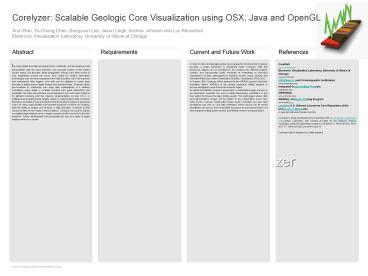zer - PowerPoint PPT Presentation
1 / 1
Title: zer
1
Corelyzer Scalable Geologic Core Visualization
using OSX, Java and OpenGL
Arun Rao, Yu-Chung Chen, Sangyoon Lee, Jason
Leigh, Andrew Johnson and Luc Renambot Electronic
Visualization Laboratory, University of Illinois
at Chicago
Abstract
Requirements
Current and Future Work
References
zer
- Split-core surface images are the fundamental
template of sediment descriptive work. Loaded
horizontally and viewed in high resolution along
a sliding plane, features such as lithologic
variation, macroscopic grain size variation,
bioturbation intensity, chemical composition and
micropaleontology are easier for geo-scientists
to interpret and annotate. - Main requirements are
- Display large amount of imagery (approximate 30GB
per hole) - Numerical data registered to the imagery
- Easy navigation
- Configurable for multi-screen display systems
- Annotations for discussion and description
- Extensible
- Corelyzer can make use of high-resolution tiled
LCD display to give geo-scientists a large-scale
perspective, helpful in processing and comparing
high-resolution digital line-scan images of cores
measuring up to hundreds of feet long. Using LCD
tiled-displays will overcome the difficulty of
correct color perception about cores under poor
lighting condition in drilling sites. To display
such huge amount of imagery data, a
level-of-detail texture paging scheme is
developed. Images are first spliced into small
blocks in different levels. Depending on the
scientists region of interest, Corelyzer will
dynamically switch to the proper detail level and
load the corresponded image blocks. With this
approach, a user can browse gigabytes of core
images and compare them side-by-side with real
split cores to make observing details feasible.
Ice cores drilled from lake and ocean floors,
continents, and ice sheets provide geoscientists
with the most extensive and accurate picture of
the earths climate history. For decades, these
stratigraphic records have been locked in core
repositories around the world. Now, aided by
modern information technologies and advanced
equipment like high-resolution color
line-scanners and multi-sensor data loggers, core
data can be digitized to create large amounts of
high-precision digital images and numerical data.
Corelyzer allows geo-scientists to collaborate
over huge data visualizations in a desktop
workstation using single or multiple monitors
with great interactivity and scalability. The
main user-interface was developed in Java with
native methods for efficient rendering with the
OpenGL implementation on Mac OS X. A multiple
level-of-detail texture paging system is
implemented inside Corelyzer that allows
scientists to load and interact with thousands of
meters of geological cores, for which
approximately one kilometer produces 30 GB of raw
imagery. With the ability to display core
sections in high resolution, Corelyzer is best
viewed on tiled 30 inch Apple Cinema Displays.
Corelyzer can scale to display on multiple large
displays run by a single computer all the way
down to the new MacBook. Future development will
incorporate the use of a table of Apple displays
driven by a cluster.
In order to allow all interested parties can
leverage the functions that Corelyzer provides, a
plugin framework is embedded inside Corelyzer.
With this framework, plugins can be developed to
fit Corelyzer into different projects workflow
and requirements easily. Examples of
extensibility by individual organizations
include heterogeneous database access, image
analysis and Persistent Multi-user Online
Collaborative Scientific Visualization
(PMOCSV). In October 2006, Corelyzer will be
deployed at the ANDRILL projects McMurdo
expedition station. ANDRILL is the newest
geological drilling program to recover
stratigraphic records from the Antarctic region.
To satisfy the ANDRILL program requirement, a
collaboration plugin and server are developed.
Scientists can work on either tiled-display
workstation or just their laptop to browse the
latest drilling results. The multi-logger sensor
data and high-resolution images will be publish
to the collaboration server then notify all the
Corelyzer collaboration plugin clients.
Scientists can also input annotations and chat on
core data interested. These records will be
stored persistently and can be used to facilitate
discussion among science teams not only during
the drilling phase but also post-drilling
research and publications.
CoreWall www.corewall.org Electronic
Visualization Laboratory, University of Illinois
at Chicago www.evl.uic.edu JOI Alliance Joint
Oceanographic Institutions www.joiscience.org Inte
grated Ocean Drilling Program iodp.tamu.edu CHRONO
S www.chronos.org ANDRILL Antarctic Drilling
Program www.andrill.org LacCore U.S. National
Lacustrine Core Repository at the University of
Minnesota lrc.geo.umn.edu/LacCore/laccore.html Co
relyzer is being developed by the University of
Illinois at Chicagos Electronic Visualization
Laboratory with funding provided by the National
Science Foundation under the agreement numbers
OCE-0602121, ATM-0307262, ATM-0071477,
EAR-0319203 and EAR-0120914 Corelyzer logo is
designed by Julieta Aguilera
JOIDES Resolution, US IODP ship Courtesy of IODP
Electronic Visualization Laboratory, University
of Illinois at Chicago































